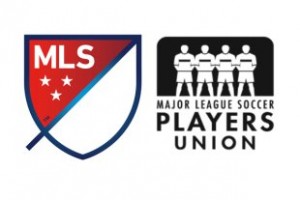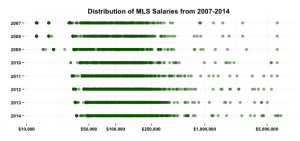
Major League Soccer and the Major League Soccer Players Union are currently struggling to agree upon a new Collective Bargaining Agreement. Image from here.
With the beginning of the MLS season rapidly approaching on March 6, the threat of a Major League Soccer (MLS) players’ strike is becoming increasingly likely after the Collective Bargaining Agreement (CBA) expired on January 31, 2015. The major issue currently being discussed is the idea of free agency, as the Major League Soccer Players Union (MLSPU) is hoping to secure the ability for players to receive bids from and negotiate contracts with multiple prospective teams. Some form of free agency is seemingly the norm throughout sports – unrestricted free agency is common throughout the rest of the soccer world and various restricted forms are also present in U.S. sports, such as in the National Football League (NFL) and Major League Baseball (MLB).
MLS executives are strongly opposed to any type of free agency, believing that player salaries would increase at a faster rate than the league could manage. This was most clearly seen in MLB – after free agency was implemented in 1976, up to present day, players salaries increased a massive 1,600 percent (even after adjusting for inflation). MLS executives believe that the league’s success in the American sports landscape is due to its “measured growth” and “centralized control,” both of which are threatened by free agency.
Free agency is strongly linked to another major topic in the negotiations, minimum player salaries and the overall salary cap. The MLSPU is hoping to increase both of these amounts and certainly this is necessary to further help MLS continue to grow and survive in the American sports landscape. Income disparity in the MLS is a huge issue, especially compared to other American sports leagues. For example, newly signed Orlando City FC player Kaka will make $7 million this season, more than the lowest 160 paid players in the MLS combined. The following graphic further illustrates the gap between players at the bottom and the top of MLS salary pool.

Wide distribution of MLS salaries, resulting in a huge disparity between the highest and lowest paid players. Image from here.
So far, limited progress has been made in the negotiations. Minor issues have been agreed upon, such as compensation for public appearances and moving expenses when players switch teams. Some players have indicated that they are willing to go on strike if the major issues aren’t resolved before the season is slated to begin. Unfortunately, a strike would probably do more harm to the league than good, as players would lose their salaries and benefits and star players may be inclined to sign with other teams outside of MLS.
However, the MLS season could still go on without a new CBA and no U.S. sports league is actually required to have one (in fact, MLS did not have a CBA from 1994-2004). A CBA is typically used for the league’s protection from player lawsuits filed under Section 1 of the Sherman Antitrust Act, where “team owners are barred from conspiring to impose anti-competitive restrictions on player compensation and employment.” If this occurs, the former CBA rules outlining salary and compensation rules would still be in effect. But it’s also important to note that the previous CBA was finalized five days before the regular MLS season started – so maybe all this fuss is for nothing and the MLS and MLSPU are really just swimming in time…

Happy faces all around when the previous Collective Bargaining Agreement (CBA) was agreed upon in 2010. Image from here.

Pingback: MLS’s New CBA – Baby Steps | Soccer Politics / The Politics of Football
It seems that while salaries have gone up for MLS players, most of those raises has come in the upper end of the pay scale. This means that those getting paid on the lower end of the pay scale are not experiencing any significant difference in pay. Like Hyun mentioned, MLS clubs are shelling out the big money for European stars who are looking for a nice lifestyle and place to end their careers. While this must be frustrating for some MLS players, I believe the idea of getting stars like Kaka and David Villa to join is to increase the attraction of MLS, and hopefully generate more revenue through ticket sales and merchandise sales. Perhaps once there is enough profit, the MLS and the MLSPU will be able to work together to increase the salaries of all players.
I feel that at least partially, the skewed salary structure stems from the salary cap that MLS imposes upon players. Only a restricted number of players per team are allowed to break the cap as “designated players”. The problem would be that most, if not all, clubs are leaving those spots open only to European footballers, and they need astronomical offer to persuade the likes of Kaka and Thierry Henry to join. I could only imagine the frustration some of the players in MLS must feel if a mid-30 player joins their team with quintuple base salary (or even more).
Great article, Connie. This seems to be a topic that we have touched on a lot in class, especially with how many sports leagues fail to protect their players, leading to comparisons of sport with slavery. The MLS is unique compared to other association football leagues because it has a salary cap. While it is true that many clubs are choosing to use these designated player spots on very expensive European players, many teams also use the designated player spot on “elite” American players such as Michael Bradley or Clint Dempsey. In agreement with Helen, these designated player spots are the only way in which MLS teams have any hope of luring proven soccer stars, international or American, away from the well-paying teams of Europe. Without such a designation, signing superstars would be impossible with a $2.5 million salary cap that is imposed on MLS teams.